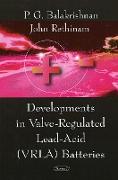Developments in Valve-Regulated Lead-Acid (VRLA) Batteries
BücherAngebote / Angebote:
Although Gaston Planté invented the lead-acid battery in 1859 in France, it took about a century to make it maintenance-free in the sense that there is no necessity for topping up the battery with water. This was made possible by the invention of a hermetically sealed nickel oxyhydroxide-cadmium battery. Though such batteries were variously called in the beginning as maintenance-free battery, sealed battery, starved electrolyte battery, absorbed electrolyte battery, etc., due to heavy litigation, particularly in the U.K., the term valve-regulated lead-acid battery (VRLAB) was coined to obviate the legal battle. The VRLAB operates on the principle of "internal oxygen cycle" without resorting to the use of catalytic recombination plugs. The binary alloys used in the initial periods of development of VRLAB had no aluminium or silver. After the introduction of Ca-Al master alloy for preparing the Pb-Ca-Al alloy, the grid casting problems were minimised. The introduction of tin to alleviate the problem of premature capacity loss helped to a very great extent in increasing the market share of VRLAB, particularly in the stationary market segment. Developments in the absorptive glass mat (AGM) separator also gave a great impetus to the popularisation of the VRLAB. The work done by the Advanced Lead-Acid Battery Consortium (ALABC) paved the way for increasing the Electric Vehicle (EV) market for VRLAB. Rapid charging of VRLAB not only helped in extending the range of EVs by reducing the down time of EVs, but also increased the life of fast-charged VRLAB. The VRLA battery technology being a comparatively new one, a lot of teething troubles were encountered in the initial periods of its introduction. A detailed analysis of the failure modes of VRLAB and remedial measures adopted by the industry is critically analysed. Extensive trials of VRLAB have been carried out to prove the utility of automotive VRLAB in Australia, Italy, Germany and Japan. Aircraft VRLAB have been proved immune to thermal runaway even though the temperature rises to 72°C. A new idea of a hybrid AGM-Gel VRLAB for use in high temperature operation is under investigation and field trial.
Folgt in ca. 10 Arbeitstagen

